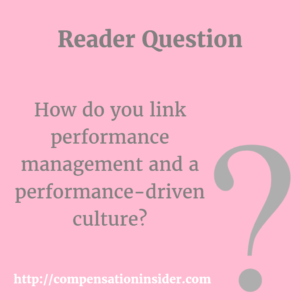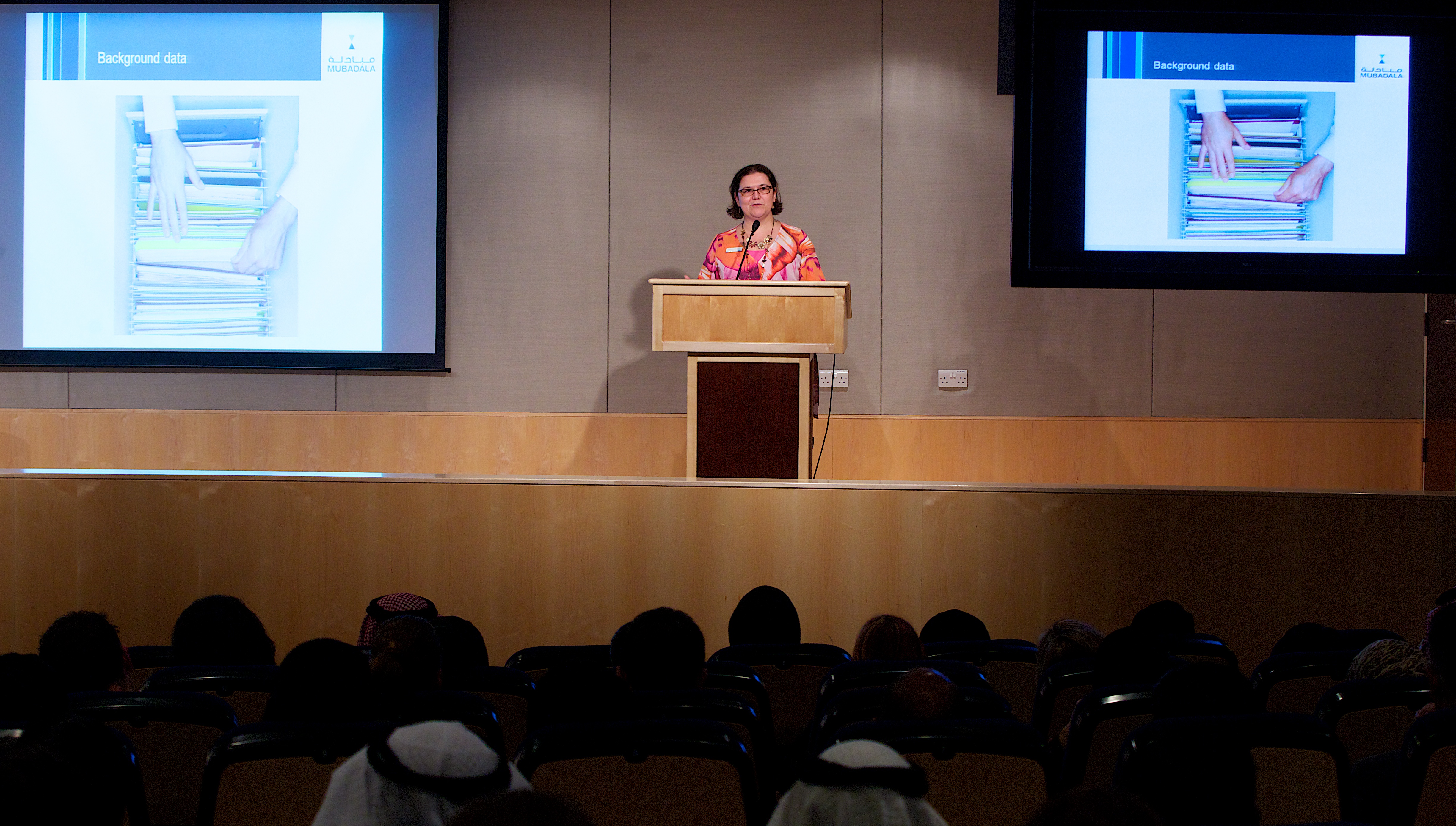Today’s Reader Question comes from the comments on one my recent posts, “Percentiles – an easy way to figure it out”. Ahsan asked : “In your opinion how do you link performance management in building a performance driven culture in the organization?”
First of all let’s make the assumption that all companies are looking to have a “performance-driven culture”. What do I mean by that ? That all organisations, whether public or private, large or small, need to get the best from their workforce in order to survive and be adapted to the needs of the people they serve (customers in the private sector, citizens and residents for the public sector). That means employees engaged and delivering to the fullest of their abilities, teams adding value (the output is larger than the sum of the individual components), and all working together in the same direction. Which direction it is, does not impact the fact that the organisation needs to have this culture of performance. What it does impact may be how this culture looks, or what the intended outcomes are.
The performance appraisal process
The cycle or process itself is what is managed by Human Resources / Compensation & Benefits and is delivered by employees and line managers. It comprises two main stages : objectives setting at the beginning of the appraisal cycle, and then (after some time), evaluation of progress or results against the objectives and feedback on the performance. And then objectives are set again or amended and the cycle goes on.
Of course, many companies don’t just want it to be an annual exercise where there are 2 conversations, one at the beginning of the year for setting the goals, and the other one at the end of the year for rating the results. This “set and forget” approach does not produce the expected results on the performance of the organisation, as it does not impact work on a regular basis. So they create “mid-year reviews” or “quarterly reviews” in order to foster more cooperation and feedback between the managers and their employees. It gives employees a more frequent opportunity for to get back on track if they are not delivering what is expected, or for employees to continue doing what they are doing, supported by the encouragement and recognition that their manager gives them.
In order to make sure that this conversation takes place, C&B is tasked with putting in place processes that allow the organisation to track these regular performance or feedback conversations between employees and their managers. That’s how we end up adding more layers of bureaucracy to the system, requiring employee self-evaluations to be formally written, manager feedback to be recorded, performance issues to be documented in case things turn sour at a later stage etc… There’s even the addition of more rounded information on performance through feedback from multiple stakeholders (peer team members, colleagues, external or internal customers etc) be it informally or more formally through 360 assessments for example.
And then, in order to ensure consistency of how the workforce is evaluated, concepts like guided distribution curve or forced ranking are thrown in the mix, “calibration sessions” or “moderation sessions” are held where managers in a comparable group compare how they have rated their employees, statistics are produced and analysed…
This is all great and very useful. But let’s not fool ourselves here. HR and C&B are only putting in place the tools that the organisation requires in order to track and deliver on these specific points in time during the performance appraisal cycle. These tools are great, but by themselves they do not create a culture of performance.
On the contrary, if the overall culture of the organisation is one of secrecy, with little communication, little trust between management and employees, decisions being communicated but with no explanation on the reason why they were made in the first place, then, the appraisal cycle becomes just another bureaucratic exercise. Both employees and managers will see it as just another “tick the box” exercise that they have to perform “because HR wants us to”. And the end result will be that the organisation will not deliver to its maximum potential.
Performance management goes beyond the performance appraisal cycle
What will create a culture of performance then ?
In my opinion, it all starts from the top. Performance management is a management process. You need to have a top management who absolutely believes in performance management. It means they spend the time discussing performance (good and bad) with their own direct reports, the Directors or VPs of your company. They spend time helping them grow their skills, especially on the soft side. They ensure that they give them the support needed to achieve the organisation’s ambitious goals, be it through time and availability, budget, people resources, introductions to the right people, access to information, coaching etc… Obviously, they communicate clearly and regularly about the goals, how they influence the future of the organisation, the reasons behind some prioritisation decisions, and how achieving or missing the goals will affect the organisation.
They make sure to foster improvement, but also to recognise and celebrate success at the individual and collective level. They also expect the same attitude from the Directors, and will hold them accountable for spreading this kind of approach in the organisation. In turn, the Directors will display the same behaviour towards their own teams and this will cascade through the organisation.
Over time, this will create the culture of performance you are looking to achieve :
- Clear goals, communicated regularly and well explained as to how they tie into the bigger picture for the organisation.
- Clear management of under-performance in order to be fair to all, including peers who will resent their under-performing colleague and their manager if no action is taken.
- Open and regular discussion between employees and managers on progress, what is going well, what could be improved and what kind of support the manager can give to the employee to help achieve the goals.
- Ability to try new things and acceptance for failure on some innovations provided some lessons are learned and the organisation and people grow as a result of it.
- Accountability of the managers on fostering this climate of openness.
- Recognition and celebration of success (it does not have to be financial though Pay-for-Performance helps).
And once again, HR and Compensation is there to support – but does not own this process and certainly does not own by itself the development of this culture. We put in place the tools to systemise the approach and ensure the organisation can track where to pay attention more. But the performance appraisal cycle alone will never result in a culture of performance in the organisation if the CEO and his top management are not willing to lead by example and foster a culture where performance is encouraged.
Related posts :




So glad I’ve found your blog Sandrine. Thanks for the insights and opinions which I’ll share with our exec team.
Thanks a lot Jan, I hope you will come back – simply subscribe through the RSS feed or by email and you won’t lose my upcoming posts 🙂
Dear
Thanks for your linked in Email. the site is Simply PERFECT . complete . with easy to search and finding subject .
what you think in Pay per performance( P.P.P.) Easy affordable comfortable way for rewarding and controlling employee performance.
but most of companies doesn’t apply performance method
Thanks Hossam I’m glad you like it. I will write a post on pay for performance in the future 🙂
Sandrine
Your article is apt, in so much as the Performanace Culture should be driven from the top. A sequel to this article would be how we HR folks can help to create that culture on the top. Any ideas or experiences on this side will be welcome.
Will think of it 🙂